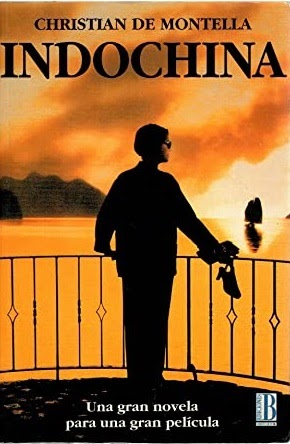
Christian de Montella: Indochina
Original language: French
Original title: Indochina
Translation: Manuel Serrat Crespo
Year of publication: 1992
Valuation: Alright
How passionate is love when it is true! There are no barriers in the world that can come between two loved ones, nor obstacles that separate them! TRUE? No. Objectively no. I don’t know the alleged “goal” of existence, but it is not idealized love.
Indochina It is, after all, a well-written book: which does not mean that it is a good book (although in this case, well, yes, come on, let’s give it a pass). It happens that one – allow me the egomania – does not swallow with the characters SO SO SO passionate that they cause shame in others. But first, let’s briefly outline the argument:
In Indochina – today, more or less Vietnam – in the 1930s, Éliane, white and of French descent, is a thirty-something/forty-something – years pass in the novel – terribly rich (with an inherited fortune, which can be very clever the aunt but she is still a woman, things are clear around here), independent and powerful. Camille, her adopted daughter, is the teenage heir to the royal throne and, biologically speaking, daughter of the princes of Indochina, who died prematurely, who were also Éliane’s best friends. She go for God. By the way, the author already tells us all this, such is the presentation of characters and plot.
A young French lieutenant named Jean-Baptiste will come into the lives of these two women and turn their world upside down.
Well, so far nothing new, nothing strange, a classic love triangle with the incestuous novelty that two of the vertices are mother and daughter; Morbidity sells. A romantic novel is presupposed, we do have, of course, the attractiveness of the relatively unusual setting. Unfortunately, (almost) everything is spoiled with the construction of the characters.
Élaine is, of course, enormously attractive, and there is no male character in the entire novel who is not attracted to her. Obviously, the other two vertices of the triangle are too. To die the ugly. The bad thing is that both Jean-Baptiste and Éliane are brutally cruel, extraordinarily racist in a context where the rarity, the privileged elite, are them; You will call me naive and tell me that real life is like that, that millionaires do not become millionaires with smiles, hugs and altruism, that a century ago the European colonies were not exactly a paradise for natives. Well, okay, but then we must completely rule out the possibility of empathizing with the invaders. A person who, in his first appearance, sentences a man and his young son to death for, allegedly – or possibly, or probably, or just maybe, or maybe – could be, well, just in case, it’s not going to be, Let’s better get healthy, almost certainly not, but it doesn’t cost anything to do things right, what was I saying – trafficking opium on a very small scale, well, what do you want me to tell you, a lot would have to be redeemed to become the good guy. movie; This is not the case, at no time does the character try to evolve in that context. Well, something could be argued, he falls in love with a native, Camille, the heir to the throne of the country (how beautiful is selfless love), but of course: Camille is not a “real” native, before that she is rich, then yes. Of course. What’s more, of course.
Éliane is not far behind in terms of bonhomie: curious how, for example, he manages a strike by his workers. To her credit, I can say that her actions after finding out about the other romance is one of the most mature behaviors in the novel, which are certainly conspicuous by her absence.
The rest of the secondary characters are also horrifying. There is no man who is not a murderer and pimp (a curious euphemism for the congay), there is no woman who is not a climber insensitive to the suffering of others. The only loyalty that exists in the novel is that between the Annamites, the natives of the novel, to whom the author gives exactly no prominence. It is clear that his vision, his world, is not interesting; It is no less clear that, evidently, and in the author’s opinion, the Western reader will identify much more with the white millionaires and exploiters than with the subjugated people. The thing is that here we are all rich, corporatism is what it has, we understand each other…
I don’t want to end the review without delving into the very passionate behaviors I alluded to before: so wildly stupid that, from pregnancy, one wants to keep the book so far away while reading that one runs the risk of dislocating one’s arm. For example, two buttons: the auction scene – rarely has a character entered the scene in such a ridiculous way – and the beginning of the love affair between Jean-Baptiste and Camille – what strange syllogisms does this girl’s reasoning follow? What inextricable conclusions does she reach after such debatable axioms? -. Anyway.
But I must say, once I get it off my chest, that the truth is that it is not such a bad read; de Montella knows how to write, he has style, good rhythm and cadence, and the final story is very emotional. I have the feeling that if a different construction had been chosen, taking advantage of this final story as a prelude to the narrative instead of using it as a coda, the work would gain in whole.
But things are as they are, not as we want them to be, and even so, I do not consider this reading to have been a waste of time; I ended up enjoying it, although, fortunately, there are thousands of more interesting books out there.
Source: https://unlibroaldia.blogspot.com/2024/02/christian-de-montella-indochina.html


